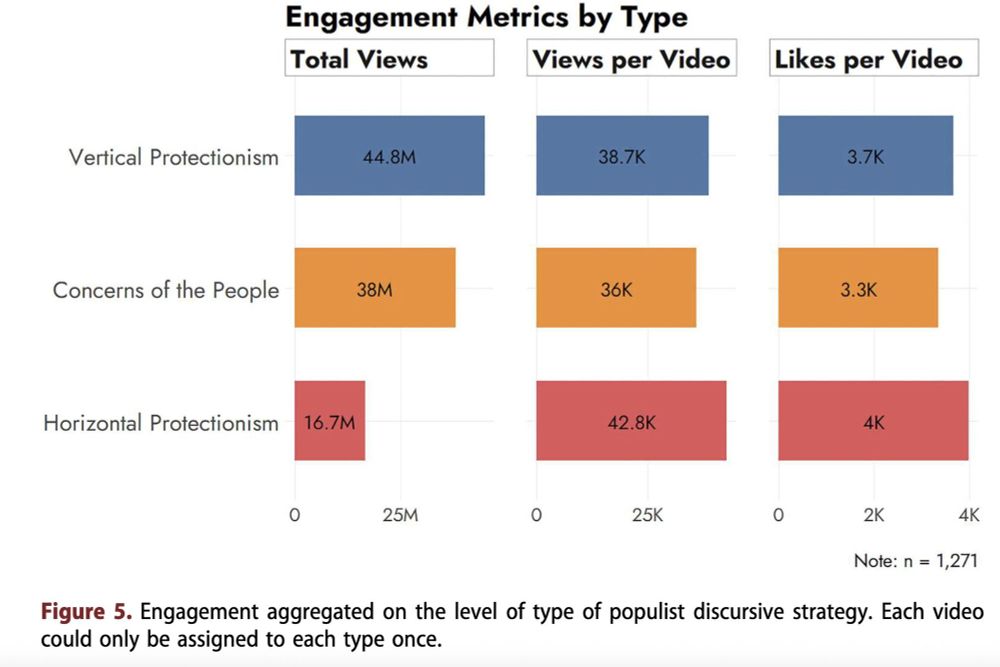
Political & Climate (Protest) Communication
Website: https://www.hendrik-meyer.com
Google Scholar: https://scholar.google.com/citations?user=j3fDB9oAAAAJ&hl=en
– Analysis focused on elites; the fringes of far-right TikTok may look quite different.
– Since EU elections, platform dynamics may have shifted, with other parties (e.g., Die Linke) catching up ahead of the 2025 federal election.
– Analysis focused on elites; the fringes of far-right TikTok may look quite different.
– Since EU elections, platform dynamics may have shifted, with other parties (e.g., Die Linke) catching up ahead of the 2025 federal election.
This may reflect ...
(a) a strategic shift toward themes that resonate with citizens, and/or
(b) entrenched exclusionary tropes of 'thick populism' that remain implicit in much of the discourse.
This may reflect ...
(a) a strategic shift toward themes that resonate with citizens, and/or
(b) entrenched exclusionary tropes of 'thick populism' that remain implicit in much of the discourse.
– Beyond identity-based attacks, the AfD strategically foregrounded real-world concerns that resonate with potential voters ... while still intertwining them with anti-elite cues.
– Beyond identity-based attacks, the AfD strategically foregrounded real-world concerns that resonate with potential voters ... while still intertwining them with anti-elite cues.
– AfD dominance: higher overall engagement rate and far greater output (from accounts with ≥100k lifetime likes) than all other German parties combined.

– AfD dominance: higher overall engagement rate and far greater output (from accounts with ≥100k lifetime likes) than all other German parties combined.
– Anti-elitism and out-group attacks generated higher per-video engagement.
– Yet most content leaned toward anti-elite messages or concern-focused themes (economy/inflation, security, rights/freedoms).

– Anti-elitism and out-group attacks generated higher per-video engagement.
– Yet most content leaned toward anti-elite messages or concern-focused themes (economy/inflation, security, rights/freedoms).
We identified 12 themes organized into 3 populist types:
1. Horizontal protectionism (identity/out-group: migrants, “wokeism”)
2. Vertical protectionism (anti-elitism/anti-institutionalism)
3. Concerns of the people (economy/inflation, security, freedoms)

We identified 12 themes organized into 3 populist types:
1. Horizontal protectionism (identity/out-group: migrants, “wokeism”)
2. Vertical protectionism (anti-elitism/anti-institutionalism)
3. Concerns of the people (economy/inflation, security, freedoms)
Timeframe: Mar–Jun 2024
– Content analysis: LLM-enhanced topic modeling (based on 'Concept Induction' by Lam et al., 2024) on 1,271 AfD video transcripts from 54 AfD accounts.
– Engagement comparison: Platform metrics from 109 politicians (5,590 videos in total)
Timeframe: Mar–Jun 2024
– Content analysis: LLM-enhanced topic modeling (based on 'Concept Induction' by Lam et al., 2024) on 1,271 AfD video transcripts from 54 AfD accounts.
– Engagement comparison: Platform metrics from 109 politicians (5,590 videos in total)
– How did AfD politicians use TikTok to communicate populist content during the run-up to the EU elections?
– How did these communication strategies relate to user engagement?
– How did AfD politicians use TikTok to communicate populist content during the run-up to the EU elections?
– How did these communication strategies relate to user engagement?
doi.org/10.1177/1464...

doi.org/10.1177/1464...
1️⃣ The protest paradigm intensifies with disruptiveness: event-, criminality-, and extremism-focused coverage crowds out substantive questions of climate justice.
1️⃣ The protest paradigm intensifies with disruptiveness: event-, criminality-, and extremism-focused coverage crowds out substantive questions of climate justice.
- Qualitative evidence shows that, based on newsroom ideologies, outlets still differ in evaluation and in who the emotional language targets—but the topical focus nonetheless converges.
- Qualitative evidence shows that, based on newsroom ideologies, outlets still differ in evaluation and in who the emotional language targets—but the topical focus nonetheless converges.
- For FFF, frame use and anger align with newsroom ideology: right-leaning outlets stress criminality/extremism; other outlets reference climate justice more often.
- For LG, coverage is more emotionally charged and dominated by criminality/extremism frames across newsroom ideologies.
- For FFF, frame use and anger align with newsroom ideology: right-leaning outlets stress criminality/extremism; other outlets reference climate justice more often.
- For LG, coverage is more emotionally charged and dominated by criminality/extremism frames across newsroom ideologies.
- Combined Word2Vec semantic mapping, an anger classifier, and qualitative close reading.
- Identified three salient frames: Global Climate Justice, Criminality, Extremism.
- Modeled outlet differences across the ideological spectrum.
- Combined Word2Vec semantic mapping, an anger classifier, and qualitative close reading.
- Identified three salient frames: Global Climate Justice, Criminality, Extremism.
- Modeled outlet differences across the ideological spectrum.


